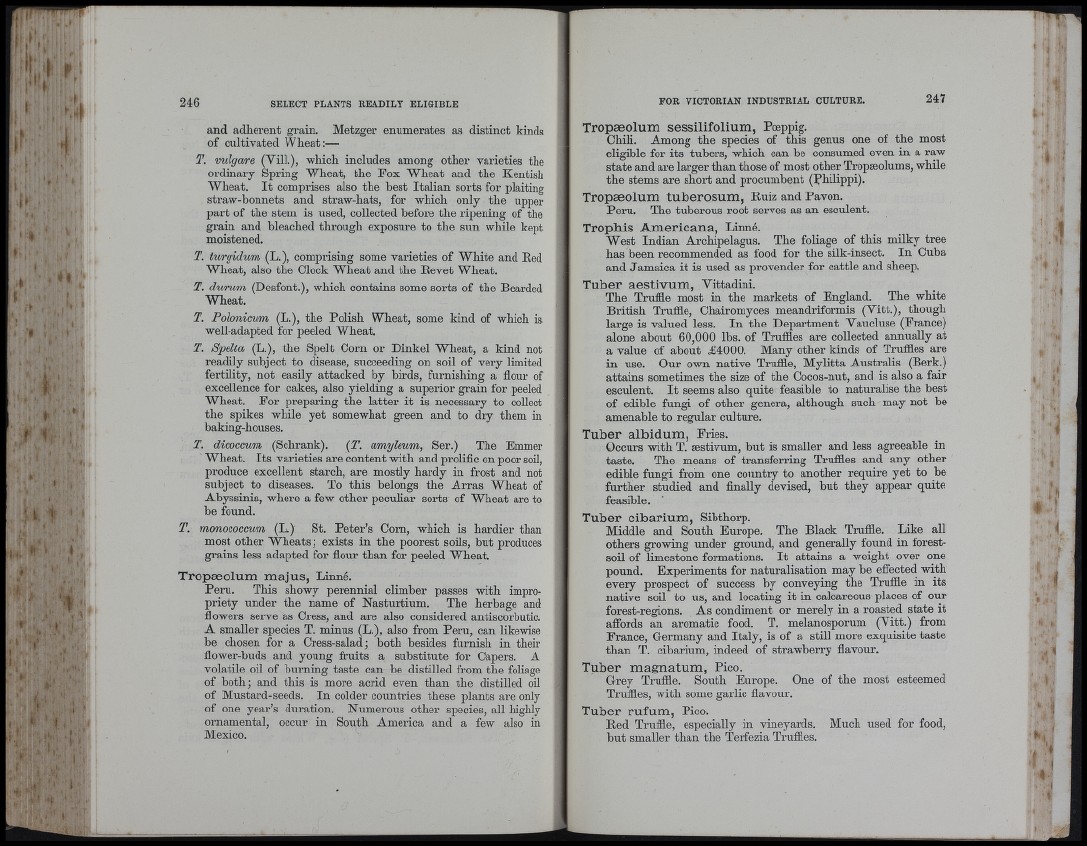
■ I 1
■î
and adherent grain. Metzger enumerates as distinct kinds
of cultivated Wheat:—
T. vulgare (Vill.), which includes among other varieties the
ordinary Spring Wheat, the Fox Wheat and the Kentish
Wheat. I t comprises also the best Italian sorts for plaiting
straw-bonnets and straw-hats, for which only the upper
part of the stem is used, collected before the ripening of the
grain and bleached through exposure to the sun while kept
moistened.
T. turgidum (L.), comprising some varieties of White and Red
Wheat, also the Clock Wheat and the Revet Wheat.
T. durum (Desfont.), which contains some sorts of the Bearded
Wheat.
T. Polonicum (L.), the Polish Wheat, some kind of which is
well-adapted for peeled Wlieat.
T. Spelta (L.), the Spelt Corn or Dinkel Wheat, a kind not
readily subject to disease, succeeding on soil of very limited
fertility, not easily attacked hy birds, furnishing a flour of
excellence for cakes, also yielding a superior grain for peeled
Wheat. For preparing the latter it is necessary to collect
the spikes while yet somewhat green and to dry them in
baking-houses.
T. dicoccum (Schrank). {T. amyleum, Ser.) The Emmer
Wheat. Its varieties are content with and prolific on poor soil,
produce excellent starch, are mostly hardy in frost and not
subject to diseases. To this belongs the Arras Wheat of
Abyssinia, where a few other peculiar sorts of Wheat are to
be found.
T. monococcum (L.) St. Peter’s Corn, which is hardier than
most other Wheats; exists in the poorest soils, hut produces
grains less adapted for flour than for peeled Wheat.
Tropæolum majus, Linné.
Peru. This showy perennial climber passes with impropriety
tinder the name of Nasturtium. The herbage and
fiowers serve as Cress, and are also considered antiscorbutic.
A smaller species T. minus (L.), also from Peru, can likewise
he chosen for a Cress-salad; both besides furnish in their
flower-buds and young fruits a substitute for Capers. A
volatile oil of burning taste can be distilled from the foliage
of both; and this is more acrid even than the distilled oil
of Mnstard-seeds. In colder countries these plants are only
of one year’s duration. Numerous other species, all highly
ornamental, occur in South America and a few also in
Mexico.
Tropæolum sessilifolium, Poeppig.
Chili. Among the species of this genus one of the most
eligible for its tubers, which can be consumed even in a raw
state and are larger than those of most other Tropæolums, while
the stems are short and procumbent (Philippi).
Tropæolum tuberosum, Ruiz and Pavon.
Peru. The tuberous root serves as an esculent.
Trophis Americana, Linné.
West Indian Archipelagus. The foliage of this milky tree
has been recommended as food for the silk-insect. In Cuba
and Jamaica it is used as provender for cattle and sheep.
Tuber aestivum, Vittadini.
The Truffle most in the markets of England. The white
British Truffle, Chairomyces meandriformis (Yitt.), though
large is valued less. In the Department Yaucluse (France)
alone about 60,000 lbs. of Truffles are collected annually at
a value of about £4000. Many other kinds of Truffles are
in use. Our own native Truffle, Mylitta Australis (Berk.)
attains sometimes the size of the Cocos-nut, and is also a fair
esculent. I t seems also quite feasible to naturalise the best
of edible fungi of other genera, although such may not be
amenable to regular culture.
Tuber albidum, Fries.
Occurs with T. æstivum, hut is smaller and less agreeable in
taste. The means of transferring Truffles and any other
edible fungi from one country to another require yet to be
further studied and finally devised, but they appear quite
feasible.
Tuber cibarium, Sibtborp.
Middle and South Europe. The Black Truffle. Like all
others growing under ground, and generally found in forest-
soil of limestone formations. I t attains a weight over one
pound. Experiments for naturalisation may he efiected v ith
every prospect of success by conveying the Truffle in its
native soil to us, and locating it in calcareous places of onr
forest-regions. As condiment or merely in a roasted state it
afibrds an aromatic food. T. melanosporum (Yitt.) from
France, Germany and Italy, is of a still more exquisite taste
than T. cibarium, indeed of strawberry flavour.
Tuber magnatum, Pico.
Grey Truffle. South Europe. One of the most esteemed
Truffles, with some garlic flavour.
Tuber rufum, Pico.
Red Truffle, especially in vineyards. Much used for food,
hut smaller than the Terfezia Truffles. »
. 4
I